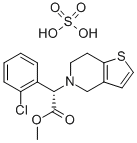| CLOPIDOGREL |
|
| (CAS 113665-84-2) |
 |
| Description: |
Clopidogrel is a well-known P2Y12 receptor blocker.
IC50 value:
Target: P2Y12 receptor
Clopidogrel (INN) is an oral, thienopyridine class antiplatelet agent used to inhibit blood clots in coronary artery disease, peripheral vascular disease, and cerebrovascular disease. It is marketed by Bristol-Myers Squibb and Sanofi under the trade name Plavix. The drug works by irreversibly inhibiting a receptor called P2Y12, an adenosine diphosphate (ADP) chemoreceptor on platelet cell membranes. Adverse effects include hemorrhage, severe neutropenia, and thrombotic thrombocytopenic purpura (TTP). From Wikipedia
|
| Product No. |
KT20849 |
| Product Name |
CLOPIDOGREL |
| Synonyms |
|
| Formal Name |
|
| CAS Number |
113665-84-2 |
| Molecular Formula |
C15H14ClNO2S |
| Formula Weight |
307.8 |
| Formulation |
A crystalline solid |
| Purity |
98%min |
| Stability |
2 years |
| Storage |
-20°C |
| Shipping |
USD45 for Europe and USA. No shipping charge once amount reach USD500 |
| Quality Control |
HNMR,CNMR,LCMS,HPLC,IR,etc. |
| Price & Availability |
In Stock. Price Negotiated. |
|
| Related Products: |
(S)-(+)-Clopidogrel hydrogen sulfate
S-(+)-Clopidogrel Hydrogen Sulfate is the S enantiomer of clopidogrel and a P2Y12 receptor inhibitor.
Target: P2Y Receptor
Clopidogrel is an effective antiplatelet agent useful for the treatment of ischemic cerebrovascular, cardiac, and peripheral arterial disease. Clopidogrel abolishes the inhibitory P2Y(AC) receptor-mediated ADP effects on prostaglandin E(1)-stimulated, cAMP-dependent phosphorylation of VASP without affecting epinephrine, thrombin, and thromboxane signaling. VASP phosphorylation is known to be closely correlated with the inhibition of platelet and fibrinogen receptor (glycoprotein IIb/IIIa) activation. Therefore, inhibition of the platelet P2Y(AC) ADP receptor and its intracellular signaling, including decreased VASP phosphorylation, is suggested as a molecular mechanism of clopidogrel action [1]. Clopidogrel ingestion reduced the thrombus volume significantly (p < 0.05) at 100 and 2600 s-1 (39 and 51% respectively). clopidogrel reduced significantly the fibrinopeptide A plasma levels and the fibrin deposition at shear rates below 650 s-1 [2]. Clopidogrel therapy resulted in a significant reduction in soluble CD40 ligand (p=0.03), a pro-thrombotic and pro-inflammatory molecule derived mainly from activated platelets. However, clopidogrel therapy had no effect on endothelial function, arterial stiffness, inflammatory and oxidative stress markers, or progenitor cells [3].
Clinical indications: Acute coronary syndrome; Peripheral vascular disease; Thromboembolism
|
|


